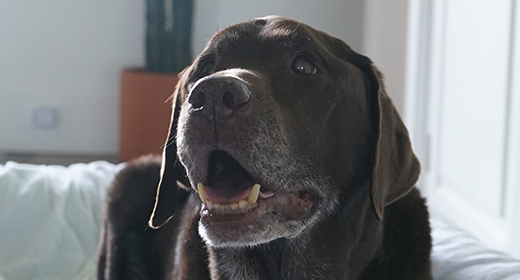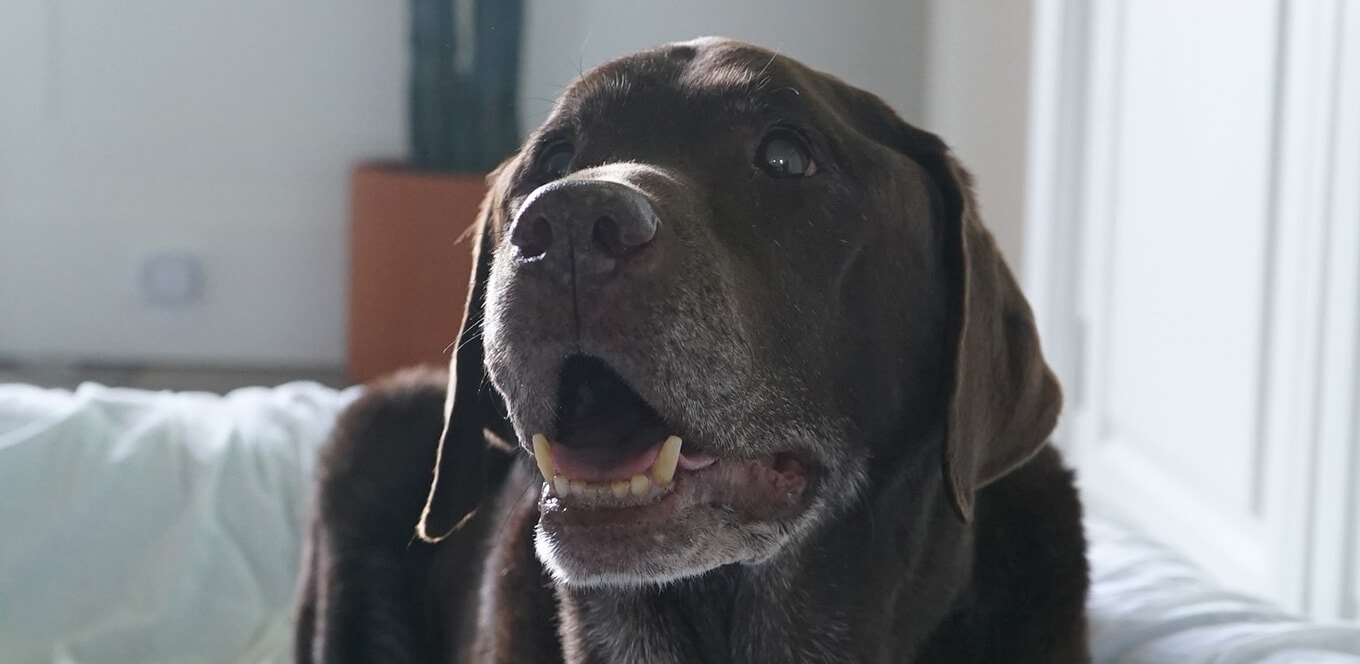

In the past, veterinarians recommended diets for senior dogs largely based on the nutritional management of diseases common to the aging process. Research, however, has shown that special nutrition can help manage body-condition problems in aging dogs, such as obesity and loss of muscle mass. Senior dogs also benefit from special nutrition to help maintain bone and joint health.
Learn more about how you can help your senior dog manage common health issues associated with aging.
Senior dogs tend to gain weight, despite consuming fewer calories, due to changes in their metabolic rate. Therefore, they can benefit from eating a diet with reduced fat levels and lower caloric density than adult maintenance foods.
Recent IAMS™ research in dogs also indicates that L-carnitine — a vitamin-like compound made in the body from the amino acids found in red meats, fish, chicken and milk — can help reduce weight in overweight dogs by escorting fat into cellular mitochondria where it is turned into energy.
Protein is the building block of muscle tissues. It is important for maintenance of muscle tissues, muscle strength and mobility. Recent research conducted by The IAMS Company has shown that senior dogs that eat a higher-protein diet better maintain muscle protein stores. By providing optimal protein levels from muscle maintenance, we can help senior dogs continue being physically active.
This research is contrary to conventional opinion that senior dog foods should contain lower protein levels than adult maintenance formulas to avoid progressive decrease in kidney function. However, senior dogs fed a high-protein diet had stable renal function and a lower death rate than dogs fed a lower-protein diet.*
During the aging process, cartilage between joints often begins deteriorating. Nutritional management can help maintain healthy bones and joints and mobility in dogs in several ways:
Some pet-food manufacturers have endorsed reduced levels of calcium and phosphorus based on the belief that excesses of these minerals are harmful to the kidneys. However, research has shown that no damaging accumulation of calcium or phosphorus was found in the kidneys of older dogs fed diets containing maintenance levels of calcium and phosphorus for four years.*
* Finco, DR. “Effects of aging and dietary protein intake of uninephrectomized geriatric dogs.” American Journal of Veterinary Research; Vol. 55, No. 9. Sept. 1994.



Rabies is one of the most serious health risks every pet parent must be aware of. In puppies primarily, this disease can manifest itself in particularly severe forms and often goes undiagnosed until it has already progressed to its later stages. Understanding the signs and symptoms of rabies in puppies can help you act as quickly as possible if your beloved pup ever becomes infected with this potentially fatal virus. Please continue reading to learn more about what rabies is, how it presents itself on a physical level, and which treatments may help save the lives of affected puppies.
Rabies is a viral infection that affects the nervous system of animals, including humans. It is transmitted through the saliva of an infected animal, usually through a bite or scratch. Symptoms include fever, headache, muscle spasms, and paralysis. If left untreated, it can lead to coma and death. Vaccination is the most effective way to prevent rabies.
Puppies can contract rabies just like any other animal, but they are generally not at high risk for it unless they are exposed to a rabid animal or live in an area where rabies is prevalent.
It is important to be aware of the signs of rabies in puppies so that you can take the necessary steps to protect your furry friend from this lethal virus. Some of the most common symptoms of rabies in puppies include:
These behavioural changes are often the first sign that rabies may be present in a puppy. Caregivers should watch for any aggressive behaviours or if their normally outgoing puppy appears withdrawn or unusually timid.
Suppose a puppy begins to lose its appetite or has trouble drinking water. In that case, this can indicate that it is infected with rabies.
Rabies can make a puppy appear disoriented and cause them to stumble when they walk.
A puppy infected with rabies may have difficulty controlling its muscles and suffer from paralysis in some areas of the body.
This is one of the more noticeable signs of rabies in puppies and is caused by the virus paralyzing the muscles controlling swallowing.
Puppies infected with rabies may make different sounds when barking or growling, such as a higher-pitched tone or a more strained voice quality.
Puppies with rabies may be overly fearful of water, even if they usually enjoy swimming or walking by the river.
Rabies can cause violent tremors and seizures, which can indicate the virus.
A puppy infected with rabies may have difficulty breathing as well as experience a choking sensation.
Rabies is a fatal virus that can cause the nervous system's deterioration, leading to death in some cases.
Pet owners must be aware of these signs of rabies in puppies, so they can seek immediate medical attention if their pet shows any of the symptoms listed above.
Several factors can contribute to rabies in puppies, such as:
Rabies is a viral infection that can be transmitted through the bite of an infected animal such as a bat, raccoon, skunk, or fox. Scratches from an infected animal too can cause rabies.
Rabies can also be transmitted through contact with an infected animal's saliva such as through a lick from an infected animal.
Occasionally, rabies can be transmitted from an infected mother to her puppies before or during birth.
Puppies that have not been vaccinated against rabies are at higher risk of contracting the disease.
Poorly maintained or unsanitary living conditions can increase the risk of puppies contracting rabies.
It is essential to get your puppy vaccinated against rabies as soon as possible. This disease can be fatal if not treated promptly and can also be transmitted to humans.
To prevent rabies, your puppy should receive a series of vaccinations at the following ages:
It is also important to keep your puppy up to date on all other vaccinations, including those for distemper, parvovirus, and hepatitis.
Before vaccinating your puppy, check with your veterinarian to determine the best vaccination schedule. Your veterinarian will also be able to provide you with more information on the risks and benefits of vaccination.
While vaccination is the ultimate prevention for your puppy, here are a few additional steps you can take to keep rabies at bay:
Rabies can be transmitted through bites or scratches from infected animals. Therefore, it is important to keep puppies away from wild animals, especially stray dogs and cats.
This will help prevent them from coming into contact with wild animals and other dogs infected with rabies.
Symptoms of rabies in puppies include lethargy, fever, loss of appetite, and changes in behaviour. If any of these symptoms are observed, it is crucial to contact a veterinarian immediately for further evaluation and treatment.
This will prevent them from coming into contact with wild animals and other dogs infected with rabies. If you must take puppies outside, supervise them closely and keep them on a leash.
Although rare, the possibility is real. To protect against this potentially fatal virus and quell any worries you may have, get your furry friend vaccinated with a rabies shot as soon as possible! If you are still concerned about their health after the vaccine, don't hesitate to consult a trusted veterinarian for advice.